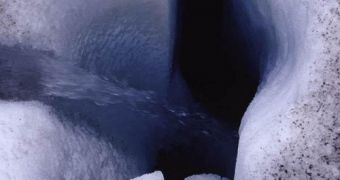Studies of places such as Greenland are evidencing the fact that land-based glaciers in these regions are currently melting, and flowing towards the sea at high speeds. But a new research shows that meltwater, long-thought to be a favoring factor in this, actually plays a different role.
Glaciers tend to flow downhill like a giant river of ice. They can undergo pretty much the same type of phenomena as in regular, liquid water rivers, but at different time scales.
As global warming and climate change begin to make their effects felt increasingly often, more and more glaciers are currently being separated from their former basis, and set on a path towards flowing into oceans.
This happens as water on their surface begins to melt, due to increased global temperatures. This water makes its way through the ices until it reaches the bedrock underneath, where it starts to pool.
This layer of liquid acts as a lubricant, making it a lot easier for the entire glacier to flow downhill. The new study shows however that this is not always the case. This is the first proposal of this type ever to be made.
Canadian researcher Christian Schoof, who is an assistant professor at the University of British Columbia (UBC) Department of Earth and Ocean Sciences, believes that water can make its way out from beneath the glaciers.
“What I find is that if you put enough water into the base, then the water can essentially erode a channel into the base of the ice, and that allows all this lubricating meltwater to drain out,” he says.
In a paper published in the December 9 issue of the esteemed journal Nature, the expert says that the more water is found under a glacier, the more its speed it reduced. Glaciers have a natural tendency to progress downhill until they reach the sea.
The investigator explains that meltwater can form from intense rainstorms, rupturing of lakes on the surface of the Greenland ice sheet, as well as from other sources. This causes the ice sheet to come under tremendous stress.
Throughout the world, atop all mountains, in the Arctic and in Antarctica, ice sheets and shelves are becoming destabilized, and are receding, Our Amazing Planet reports.
But other influencing factors may be at work other than global warming and climate change, and that is a new type of previously-unstudied flow physics.
According to the UN Intergovernmental Panel on Climate Change (IPCC), if the glaciers covering Greenland melt, than the level of the world ocean could increase by as much as 6 meters, or 20 feet.
The island has been losing ice at a rate of about 100 billion tons of ice per year since the 1990s.

 14 DAY TRIAL //
14 DAY TRIAL //